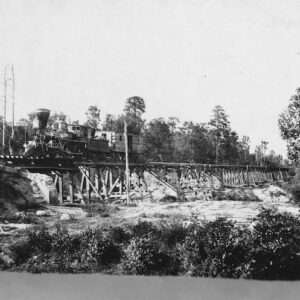Tag: Wilmington & Weldon Railroad (W&W)
Wikipedia says: The Wilmington and Weldon Railroad (W&W) name began use in 1855, having been originally chartered as the Wilmington and Raleigh Railroad in 1834. At the time of its 1840 completion, the line was the longest railroad in the world with 161.5 miles (259.9 km) of track. It was constructed in 4 ft 8 in (1,422 mm) gauge. At its terminus in Weldon, North Carolina, it connected with the Seaboard and Roanoke Railroad (to Portsmouth, Virginia) and the Petersburg Railroad (to Petersburg, Virginia). The railroad also gave rise to the city of Goldsboro, North Carolina, the midpoint of the W&W RR and the railroad intersection with the North Carolina Railroad.
Among the early employees of the W&W RR was assistant engineer William G. Lewis. The future Civil War general began his railroad career in 1858. From 1854 to 1871 S.L. Fremont was Chief Engineer and Superintendent. Fremont, North Carolina, is named in his honor.
During the American Civil War, the railroad was used heavily by the Confederacy for transporting troops and supplies. The railroad also played a key role in the Siege of Petersburg. The cities of Wilmington and Goldsboro fell in 1865 at the end of the war, and the railroad was badly damaged.
The railroad managed to rebuild after the war. By 1866, the bridge over the Cape Fear River was rebuilt, which reconnected the line to Wilmington. By 1869, the W&W and other railroads in the Carolinas were purchased by a group of Baltimore capitalists including William T. Walters. This group of lines were advertised as the Atlantic Coast Line, but were still operated independently.
Showing the single result
